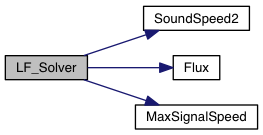|
PLUTO
|
|
PLUTO
|
Lax-Friedrechs (Rusanov) Riemann solver for HD. More...
#include "pluto.h"
Go to the source code of this file.
Functions | |
| void | LF_Solver (const State_1D *state, int beg, int end, double *cmax, Grid *grid) |
Lax-Friedrechs (Rusanov) Riemann solver for HD.
Solve the Riemann problem for the adiabatic and isothermal HD equations using the Lax-Friedrichs Rusanov Riemann solver with local maximum characteristic speed:
![\[ \hat{F}_{i+\HALF} = \frac{F^L_{i+\HALF} + F^R_{i+\HALF}}{2} - c^{\rm max}_{i+\HALF}\frac{U^R_{i+\HALF} - U^L_{i-\HALF}}{2} \qquad{\rm where}\quad c^{\rm max} = \lambda_{\rm max}\left( \frac{V^R_{i+\HALF} + V^L_{i+\HALF}}{2}\right) \]](form_48.png)
where  is a function of the arithmetic average between the left and the right states.
is a function of the arithmetic average between the left and the right states.
On input, this function takes left and right primitive state vectors state->vL and state->vR at zone edge i+1/2; On output, return flux and pressure vectors at the same interface i+1/2 (note that the i refers to i+1/2).
Also during this step, compute maximum wave propagation speed (cmax) for explicit time step computation.
Reference:
Definition in file tvdlf.c.
| [in,out] | state | pointer to State_1D structure |
| [in] | beg | initial grid index |
| [out] | end | final grid index |
| [out] | cmax | 1D array of maximum characteristic speeds |
| [in] | grid | pointer to array of Grid structures. |
Definition at line 38 of file tvdlf.c.
